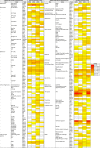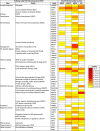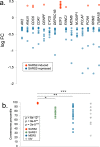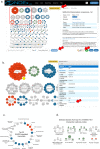Consensus transcriptional regulatory networks of coronavirus-infected human cells
- PMID: 32963239
- PMCID: PMC7509801
- DOI: 10.1038/s41597-020-00628-6
Consensus transcriptional regulatory networks of coronavirus-infected human cells
Abstract
Establishing consensus around the transcriptional interface between coronavirus (CoV) infection and human cellular signaling pathways can catalyze the development of novel anti-CoV therapeutics. Here, we used publicly archived transcriptomic datasets to compute consensus regulatory signatures, or consensomes, that rank human genes based on their rates of differential expression in MERS-CoV (MERS), SARS-CoV-1 (SARS1) and SARS-CoV-2 (SARS2)-infected cells. Validating the CoV consensomes, we show that high confidence transcriptional targets (HCTs) of MERS, SARS1 and SARS2 infection intersect with HCTs of signaling pathway nodes with known roles in CoV infection. Among a series of novel use cases, we gather evidence for hypotheses that SARS2 infection efficiently represses E2F family HCTs encoding key drivers of DNA replication and the cell cycle; that progesterone receptor signaling antagonizes SARS2-induced inflammatory signaling in the airway epithelium; and that SARS2 HCTs are enriched for genes involved in epithelial to mesenchymal transition. The CoV infection consensomes and HCT intersection analyses are freely accessible through the Signaling Pathways Project knowledgebase, and as Cytoscape-style networks in the Network Data Exchange repository.
Conflict of interest statement
The authors declare no competing interests.
Figures










Update of
-
Consensus transcriptional regulatory networks of coronavirus-infected human cells.bioRxiv [Preprint]. 2020 Jul 15:2020.04.24.059527. doi: 10.1101/2020.04.24.059527. bioRxiv. 2020. Update in: Sci Data. 2020 Sep 22;7(1):314. doi: 10.1038/s41597-020-00628-6. PMID: 32511379 Free PMC article. Updated. Preprint.
Similar articles
-
Consensus transcriptional regulatory networks of coronavirus-infected human cells.bioRxiv [Preprint]. 2020 Jul 15:2020.04.24.059527. doi: 10.1101/2020.04.24.059527. bioRxiv. 2020. Update in: Sci Data. 2020 Sep 22;7(1):314. doi: 10.1038/s41597-020-00628-6. PMID: 32511379 Free PMC article. Updated. Preprint.
-
Type I and Type III Interferons Restrict SARS-CoV-2 Infection of Human Airway Epithelial Cultures.J Virol. 2020 Sep 15;94(19):e00985-20. doi: 10.1128/JVI.00985-20. Print 2020 Sep 15. J Virol. 2020. PMID: 32699094 Free PMC article.
-
SARS-CoV-2-Encoded Proteome and Human Genetics: From Interaction-Based to Ribosomal Biology Impact on Disease and Risk Processes.J Proteome Res. 2020 Nov 6;19(11):4275-4290. doi: 10.1021/acs.jproteome.0c00421. Epub 2020 Aug 10. J Proteome Res. 2020. PMID: 32686937 Free PMC article. Review.
-
Activation of alveolar epithelial ER stress by β-coronavirus infection disrupts surfactant homeostasis in mice: implications for COVID-19 respiratory failure.Am J Physiol Lung Cell Mol Physiol. 2024 Aug 1;327(2):L232-L249. doi: 10.1152/ajplung.00324.2023. Epub 2024 Jun 11. Am J Physiol Lung Cell Mol Physiol. 2024. PMID: 38860845 Free PMC article.
-
Rapid, point-of-care antigen tests for diagnosis of SARS-CoV-2 infection.Cochrane Database Syst Rev. 2022 Jul 22;7(7):CD013705. doi: 10.1002/14651858.CD013705.pub3. Cochrane Database Syst Rev. 2022. PMID: 35866452 Free PMC article.
Cited by
-
Spatial Transcriptomics Resolve an Emphysema-Specific Lymphoid Follicle B Cell Signature in Chronic Obstructive Pulmonary Disease.Am J Respir Crit Care Med. 2024 Jan 1;209(1):48-58. doi: 10.1164/rccm.202303-0507LE. Am J Respir Crit Care Med. 2024. PMID: 37934672 Free PMC article.
-
Histone proteoform analysis reveals epigenetic changes in adult mouse brown adipose tissue in response to cold stress.Epigenetics Chromatin. 2024 Apr 27;17(1):12. doi: 10.1186/s13072-024-00536-8. Epigenetics Chromatin. 2024. PMID: 38678237 Free PMC article.
-
Conserved immunomodulatory transcriptional networks underlie antipsychotic-induced weight gain.Transl Psychiatry. 2021 Jul 22;11(1):405. doi: 10.1038/s41398-021-01528-y. Transl Psychiatry. 2021. PMID: 34294678 Free PMC article.
-
Comparative transcriptome analysis reveals key epigenetic targets in SARS-CoV-2 infection.NPJ Syst Biol Appl. 2021 May 24;7(1):21. doi: 10.1038/s41540-021-00181-x. NPJ Syst Biol Appl. 2021. PMID: 34031419 Free PMC article.
-
Histone proteoform analysis reveals epigenetic changes in adult mouse brown adipose tissue in response to cold stress.bioRxiv [Preprint]. 2024 Jan 22:2023.07.30.551059. doi: 10.1101/2023.07.30.551059. bioRxiv. 2024. Update in: Epigenetics Chromatin. 2024 Apr 27;17(1):12. doi: 10.1186/s13072-024-00536-8. PMID: 38328142 Free PMC article. Updated. Preprint.
References
Publication types
MeSH terms
Substances
Grants and funding
LinkOut - more resources
Full Text Sources
Research Materials
Miscellaneous

